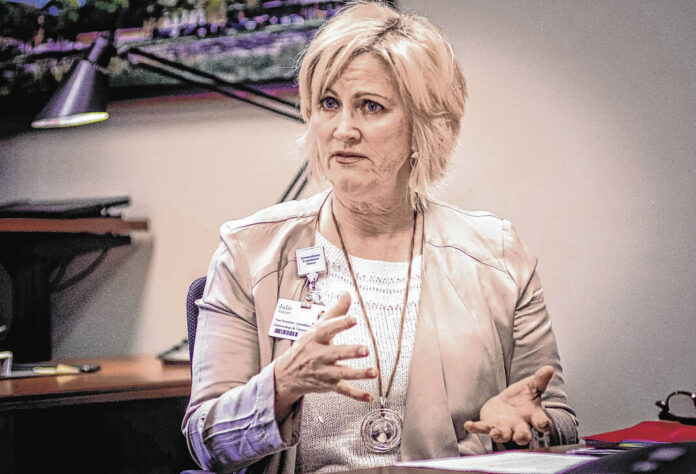
Photo by Andrew Laker | Columbus Regional Health Columbus Regional Health Vice President of Community Partnerships and Corporate Responsibility Julie Abedian is shown in an interview at Columbus Regional Hospital on Thursday, May 30, 2019.
Local officials say they are preparing to launch a community-wide initiative this year aimed at addressing what they described as a deepening mental health crisis in Bartholomew County and the surrounding area.
Over the past year, Columbus Regional Health’s Healthy Communities initiative has been laying the groundwork for the new mental health effort, including getting resources aligned and staffing in place, with tentative plans for a formal launch in April, said Julie Abedian, CRH vice president of community partnerships and corporate responsibility.
The mental health initiative — which is expected to involve the Columbus city and Bartholomew County governments, as well as the county’s health system, local behavioral health system and local education system — will largely be modeled after the collaborative effort that led to the creation of the Alliance for Substance Abuse Progress, or ASAP, an organization that was launched in 2017 as part of the community-wide effort to combat the opioid crisis and substance use, officials said.
Currently, the mental health initiative is still in its initial stages and has yet to be named, Abedian said. This year, officials hope to gain a common understanding of the community’s current assets and challenges and best-practice solutions to the local youth and adult mental health crises.
Next month, representatives from the city of Columbus, Bartholomew County, Centerstone, CRH and the Bartholomew Consolidated School Corp. are expected to hold a “retreat” to discuss the initiative and how mental health has impacted each of their organizations.
“We’re just getting started on this work, even though we’ve been planning for it for a year,” Abedian said.
The push to launch the mental health initiative has been driven in large part by findings from the 2021 Community Health Needs Assessment for CRH’s service area, Abedian said.
The assessment, which was conducted by healthcare consulting firm Professional Research Consultants Inc. on behalf of CRH, includes surveys of residents and key informants in Bartholomew County and other communities that CRH serves, as well as vital statistics and other health-related data.
Similar assessments have been conducted every few years since 1996, according to Healthy Communities’ website.
The 2021 results, however, painted a somber picture of the community’s mental health status compared to state and national figures — as well as the previous local assessment in 2018, with significant increases in the percentage of local respondents who reported that their mental health was fair or poor, had considered suicide in the previous year and were unable to receive mental health services when they needed them.
At the same time, the 2021 assessment found that there were considerably fewer mental health providers per capita in Bartholomew County compared to the U.S. at large.
“On every measure related to mental health, things are worse than they were three years ago,” Abedian said.
In the 2021 assessment, 25.9% of respondents in Bartholomew County rated their own mental health as “fair” or “poor,” compared to 13.4% nationwide and up from 14.9% among Bartholomew County respondents in the 2018 local assessment.
In addition, 31.8% of respondents in Bartholomew County — nearly 1 in 3 — had been diagnosed with a depressive disorder, compared to 21% in Indiana and 20.6% nationwide.
The suicide rate per 100,000 people in CRH’s service area also has roughly doubled from 9.2 per 100,000 people from 2007 to 2009 to 19 per 100,000 from 2017 to 2019, according to the 2018 and 2021 assessments. By comparison, the U.S. suicide rate rose from 11.3 to 14 per 100,000 people over the same time period.
The 2021 assessment also suggests that mental health issues may be more prevalent among younger Bartholomew County residents, women and low-income residents.
A total of 42.1% of respondents in Bartholomew County ages 18 to 39 reported experiencing symptoms of depression over the past year, as well as 36.3% of women and 46% of all low-income residents, the assessment states.
Additionally, 17.2% of Bartholomew County residents ages 18 to 39 reported considering suicide in the past year, compared to 5.5% of respondents in that age group in 2018.
Overall, the 2021 assessment states that 9.8% of respondents in Bartholomew County considered killing themselves during the previous year, up from 6.9% in the 2018 assessment.
At the same, 10.8% of Bartholomew County responded said in the 2021 assessment that they were unable to get mental health services when they needed them in the previous year, compared to 3.5% in the 2018 survey.
Columbus Mayor Jim Lienhoop said last month that he supports the new initiative and plans to “put some effort behind (it)” this year to “increase the chances of success.”
“One of the things that we just haven’t done well in Indiana for the last decade or so is respond to people who have mental health issues,” Lienhoop said. “Because we don’t, those issues tend to manifest themselves either in terms of substance use disorder, homelessness, other kinds of behaviors that are difficult for us to respond to and place and burden on our institutions, be they health care or police and emergency responders and so forth. Hopefully, this mental health initiative that (we will launch) in partnership with healthy communities will have some of the successes that we’ve seen with ASAP.”
While officials still do not know where the new initiative will ultimately lead, they expressed optimism that they can make a positive impact if they work together.
“We have a history in our community of being able to improve our community’s health when we work collectively,” Abedian said. “…Even though the mental health crisis seems overwhelming and daunting, we do believe and have confidence that if we approach this set of issues the same way that we did with the opioid crisis and with infant mortality, that we can make a positive impact on our community’s mental health.”




